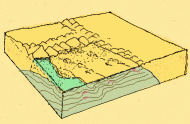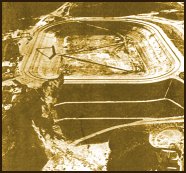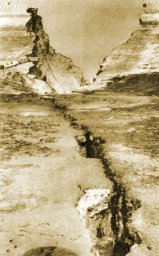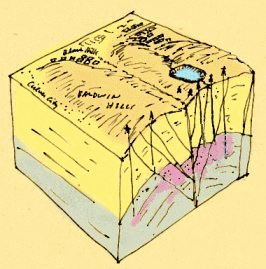
This section is a brief review of problems arising from unusual conditions and operations in the Baldwin Hills area of Los Angeles.
First, note the setting: an anticlinal dome in the middle of the (otherwise subsiding) Los Angeles basin, with active periodic tectonic movement.

In December of 1963 the newly constructed baldwin Hills Reservoir failed with five deaths and a great deal of property damage. The event was captured on TV. (See recent "Wrath of God" episode on the Discovery channel for live coverage of the failure.)
Here is a view of the cracked dam after the failure, looking south.
 .................
................. 
Also a view of the reservoir floor, showing the crack in the lining. The ground is offset down to the left.
The role
of central graben subsidence, accelerated by oil extraction, supplemented
by reinjection of waste brine into the ground, on fault movement beneath
the reservoir is indicated in the animated graphic following. Injection
pressures exceeded hydrofracture pressures and the recorded timing of the
fault offset (which was dutifully recorded by the reservoir owner) indicate
the injection as being the decisive factor. (See references)

ANNOTATED REFERENCES:
Meehan, RL (1984):" The Atom and the Fault: Earthquakes, Experts, and Nuclear Power", The MIT Press, Boston. This book discusses the evaluation of geologic fault hazards v. high hazard facilities in California.
Meehan, RL; Hamilton, DH (April 23, 1971): "Ground Rupture in the Baldwin Hills," Science. 172, no. 3981, 333-344. This report describes the role of oil drilling and water re-injection in causing the Baldwin Hills Dam collapse.
Meehan,
RL; Hamilton, DA (Spring 1992): "Cause of the 1985 Ross Store Explosion
and Other Gas Ventings, Fairfax District, Los Angeles," Engineering Geology
Practice in Southern California. 20. This report describes how water-flooding
operations can lead to methane hazards in and around oil fields.